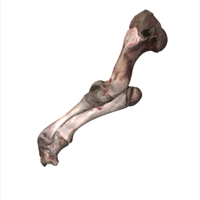by John Gardner

On 4 November Sir Alan Langlands will officially open the newly refurbished premises in DJCAD that will house Kestrel 3Dís state of the art 3D colour laser Scanning and Imaging Centre. The centre will allow staff and students to access this exciting new technology for research purposes, opening up many new avenues of possible research, and facilitating and improving existing research at the college.
Kestrel 3D Limited was formed following the merger between Arius3D Europe and the award-winning Multimedia Team, formerly of the National Museums of Scotland. The company has licensed the rights to the Arius3D technology in Europe plus the rights to expand globally in due course. This cutting edge technology simultaneously captures the 3D geometry and true colour of objects in near microscopic detail and in superb quality. When an object is scanned, the system simultaneously collects and records its colour, texture and precise geometric details. The point cloud data is then transformed into a high quality, 3D-colour image, with the option of a variety of file sizes and formats to suit the application.
The benefits for researchers were immediately apparent to Scottish Enterprise, who persuaded Kestrel 3D that they should discuss the research opportunities with the University. The Directors of Kestrel 3D decided that this was a perfect site for a 3D Scanning and Imaging Centre, with the aim of developing and supporting research led activities. The cost of refurbishing this space, which previously had been an under utilised storage area, was partly met by generous support from Scottish Enterprise Tayside, and partly by the University through funds managed by Research and Innovation Services.
Professor Steve Partridge, Associate Dean of Research and Enterprise at DJCAD said, "This is a great coup for the University. This 3D centre will offer research time across the Universityís many disciplines, particularly in the creative industries, design, engineering, and life sciences. We believe the technology to be truly ground-breaking and the likely applications are extending week by week as colleagues and partners are consulted. Commercial projects and proof of concept studies will be undertaken alongside pure research."
The Kestrel 3D Scanning Centre will work closely with the Centre for Digital Imaging, based in the School of Television and Imaging, and its Course Director, Chris Rowland. Chris will be able to advise research colleagues in the University on the use of the Kestrel 3D scanning technology and benefits to individual research projects. Chris, who is currently developing a research project utilising the Arius3D technology with Dr Fraser Harold in the School of Medicine, clearly sees the advantages to research projects that will arise from having access to this new technology.
Kestrel 3D predicts that because of the quality of the images which the Arius3D laser scanning technology produces, this will revolutionise the way in which products and artifacts are marketed, studied or stored and will create a host of opportunities across the engineering, museum and heritage, education and training, creative and medical sectors, to name but a few.
Jerry Connolly, Chief Executive of Kestrel 3D Limited said, "We have done some work on scanning human organs which we believe could revolutionise medical training. It means you can do away with specimen jars and body parts and avoids any problems with retaining patientís organs. With Arius3D technology the images are so real you feel you can almost pick them up."
The University is keen that research staff make full use of the opportunities offered by this new facility to explore ways in which the scanning technology can be of assistance in their own fields of research. Kestrel 3D wants to encourage research staff to explore the new technology and find ways in which it can be used in any number of research areas.
As well as the opening event, an on-going programme of workshops and demonstrations will be arranged to allow research staff to view the technology in action and investigate its usefulness for their own research. Faculty specific workshops will be arranged for the faculties of Engineering and Medicine and for the School of Design.
Kestrel 3D has said that its staff are always keen to speak to any University researchers about their projects, and to organize workshops or demonstrations. Kestrel 3D images can be used in multimedia applications, digital archiving, quality assurance, wear and degradation analysis and as a precise non-contact measurement tool.

from top:
Images of objects after 3D laser scanning: